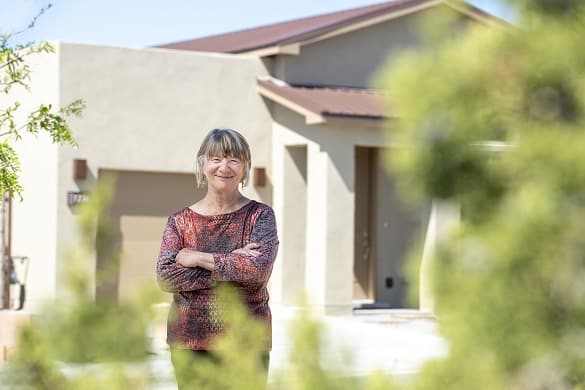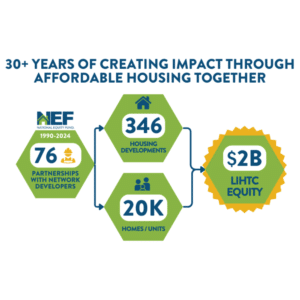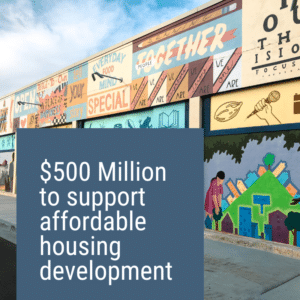As the cost to buy and to build a home climbs, and demand greatly outpaces supply, affordable housing organizations are working to help families realize the dream of homeownership. Through the challenges of the COVID-19 pandemic and shortages in building materials, construction workers, and affordable housing stock—affordable housing organizations have been there to support families.
This month, we interviewed four NWOs focusing on wealth building through homeownership to find out how they have adjusted, met challenges as opportunities, and relied on their partners. They’ve also shared their advice for others looking to replicate their successful models.
Come Dream Come Build, Brownsville, TX

Just two years ago, it was possible for families earning $25,000 to $28,000 (55% or 60% of AMI) to purchase a home in the Rio Grande Valley, home of Come Dream Come Build (CDCB). That is not so today, said CDCB’s Executive Director Nick Mitchell-Bennett.
“The biggest opportunity open to CDCB is meeting the growing needs of low-income families in our region. This can sometimes feel like a challenge,” Mitchell-Bennett said.
It has quickly become a high-cost market when comparing income to housing costs, making it very difficult for these families to buy a house. Over the last 10 years home prices have risen 75% and incomes have risen just 15%. In the last 12 months, median sales prices in Brownsville have ballooned 45% from $159,000 to $230,000.
CDCB has introduced its MiCASiTA model, one of six winners of the Affordable Housing Breakthrough Challenge with Enterprise Community Partners & Wells Fargo. It allows new buyers to build a smaller home to meet their current need, and grow toward a larger home over four years. It includes an online housing design and counseling system, and a loan that also grows with the home. The units are built in CDCB’s new off-site manufacturing facility so CDCB can franchise it to other nonprofits, like its Community Loan Center small-dollar loan product.
In 2021 CDCB opened a new 129-lot subdivision at Palo Alto Groves as part of a larger 675-lot project over the next seven years that includes market-rate homes to offset losses on affordable homes for low-income buyers. CDCB has pre-sold 106 in just two months to market-rate buyers. The remaining 23 are part of a New Markets Tax Credit (NMTC) deal with assistance to offset the increased material cost.
CDCB’s main focus is building wealth for low-income families. They have had more than 1,000 new clients in the previous year, and they work to help these families prepare to buy a home.
“The house is a tool to help build wealth. Focusing on developing homebuyers is part of a larger philosophy. If we can help a family become homebuyer-ready, they have sound credit, savings, and income. This is the basis of growing wealth,” Mitchell-Bennett said.
CDCB often uses no public subsidy in its developments to maintain flexibility.
“With private sources of funds we can move quicker and adjust to the market. We actually save money this way,” Mitchell-Bennett said.
CDCB was one of the first groups to mix CDBG with private loans funds to create a new loan product. When the only grocery store in downtown Brownsville closed a year ago, creating a food desert, CDCB stepped in to develop a small market. They recognized a lack of permanent supportive housing rental units south of San Antonio, and are now developing those as well.
Partnering with similar groups is key to improving. “Over the past 10 years we have started to partner with other groups like ours that are more than just a lender, they do it all. Being alone is not good, partnerships are the best way to go,” Mitchell-Bennett said.
“We created our system out of necessity, a do-or-die mentality,” Mitchell-Bennett said. “When you are a long way from others you need to figure it out if you want to meet the need. I don’t think we are special nor do we have special skills, I just think we don’t understand the words, ‘it’s not possible to do that.’ If we want to create wealth we need to look for ways to do so.”
Atlanta Neighborhood Development Partnership, Atlanta, GA

Atlanta Neighborhood Development Partnership (ANDP) is focused on additional production to meet critical supply gaps. Last July, ANDP launched “Closing the Gap,” a plan to create and preserve 2,000 affordable housing units in metro Atlanta, where available housing stock is less than a one-month supply. The $440 million project will create 1,200 affordable apartment units and 750 single-family homes, including 500 for homeownership.
“We look forward to continuing to increase availability of affordable housing, to fewer market disruptions, less sluggish supply chains, and more predictable development production,” said Tayani Suma, ANDP Senior Vice President, Real Estate, and NeighborWorks Capital Board and Loan Committee Member.
ANDP offers renovated and new homes affordable to low- and moderate-income buyers with a household income between $43,000 – $103,000 (50 and 120% of AMI). ANDP’s production has tripled in the last five years, in part due to enterprise-level capital from NeighborWorks Capital’s Strategic Growth Fund, the Capital Magnet Fund, and investments from bank programs and impact investors. This influx has helped ANDP secure competitive federal resources to scale further.
Creating homeownership opportunities in its neighborhoods helps ANDP provide key impacts, Suma said, including:
Solid foundations for families: Homeownership is proven to positively impact educational achievement, health outcomes, civic participation, and economic opportunity. “Changing a family’s health and financial trajectory is of utmost importance” to ANDP, Suma said.
Stabilizing neighborhoods: Communities that ANDP focuses on have seen decades of disinvestment, the foreclosure crisis, lingering negative equity during the economic and housing recovery period, and loss of considerable family wealth. Today, single-family homes are increasingly owned by speculative investors instead of families. “We believe the strongest position to prevent gentrification and displacement is stable, affordable homeownership,” Suma said.
Generational wealth: A 2019 study of ANDP customers remaining in their homes beyond five years found 90% were first-time homebuyers, and 91% received some form of down payment assistance. The average home value appreciated 76%, for an average wealth gain of $88,797; a soon-to-be-released update shows that’s grown to $130,000. “Homeownership builds wealth and creates economic opportunity which impacts a family for generations,” Suma said.
They’re working to offset higher home prices caused by current market conditions by revisiting homebuyer subsidies with government program partners, and by identifying additional down payment resources. For example, they became a member institution of the Federal Home Loan Bank of Atlanta, which gives metro Atlanta low-income homebuyers earning less than $70,000 (80% of AMI) access to up to $1 million in down payment assistance each year.
Organizational focus on equitable economic opportunity extends to ANDP’s partnerships, with a goal of building partnerships with Black-owned businesses. They will invest or lend $50 million to small Black-owned builders and developers by 2025.
ANDP employs a risk-sharing model with small builders, focusing on material costs and labor availability. Depending upon the program funding source, they may investigate increasing development subsidies to address the gap created by rising costs. They’ve also worked with some partners to reduce the square footage of new construction. What started as a beta test for smaller infill lots in dense neighborhoods has garnered positive, market response.
Their partners share both risk and reward, including a share of gains and losses. ANDP intensely vets partners for shared mission and values. They then slowly grow smaller contractors’ capacity, addressing problems along the way.
ANDP has had an increasing number of opportunities to share its single-family development model. They typically share examples of process flow, legal documents, vetting process, and more.They’ve even had organizations from other cities visit ANDP to see their work firsthand.
NeighborWorks Northeast Nebraska, Norfolk, NE

NeighborWorks Northeast Nebraska (NWNEN) sees opportunity in the increasing number of clients that want to become homeowners.
“The demand never really dwindled,” said NWNEN’s CEO Roger Nadrchal. “The market is tough.”
NWNEN’s main program is Purchase/Rehab/Resell, focusing on home ownership for income-qualified families.
“Our number one priority is ensuring there’s a program people can take advantage of to become homeowners. We make sure to do whatever we can to make those programs accessible,” Nadrchal said.
NWNEN focuses on rehabilitation because of its affordability for the lower- to moderate-income families they serve. While they would like to add new construction to the housing stock, the price for a buyer at $72,000 (100% AMI) creates a large gap: the same house NWNEN built in 1997 for $87,000 now costs $270,000 to build due to the increased cost of materials and regulations.
With increased prices of homes, materials and labor, they have increased subsidies from capital and grant dollars to help lower the price point to an affordable rate for their customers. While the grant opportunities are not yet there to match demand, NWNEN is hopeful they’ll be able to access new funding from the state as it comes in.
“We know that salaries haven’t tripled or quadrupled in value. The gap continues to get bigger and bigger,” Nadrchal said.
NWNEN serves seven counties with homes largely concentrated in Norfolk and Columbus, two communities of 25,000, and the rest in surrounding small, rural communities. They’ve seen a small uptick in people moving into the community from outside the region or state.
They also have a new-construction workforce housing program for middle-income families. While construction has continued through the pandemic, less contractor availability has slowed the process, meaning homes are not selling as quickly.
To nurture reliable partners and builders, NWNEN relies on its existing relationships and, working in smaller communities, knowing its contractors and working with them consistently.
“A key is that we’ve known who we’re working with, and continue to build our relationships with them,” Nadrchal said.
NWNEN’s programs are well-known throughout Nebraska, where other nonprofits have reached out to model our approach. NWNEN will meet with them to explain their program and are willing to share documents they use in it, such as checklists and step-by-step procedures.
“We are always willing to share. Every organization and community is different, but a lot of the basics can be replicated quite easily,” Nadrchal said.
Homewise, Santa Fe, NM

The increase in potential funding from public and private sectors is an opportunity for Homewise to grow the size, scope and impact of its work, said President Laura Altomare.
“Homewise’s core homeownership strategies help to strengthen the financial wellbeing of individuals and families and increase neighborhood vitality.”
Homewise offers a full range of home purchase and improvement services throughout New Mexico. Their trusted advisors guide prospective homeowners throughout the entire home purchase process. Financial coaching and homebuyer education come early in the process to help create a financial action plan for customers. Then, on-staff Realtors assist with finding a home that meets customer needs within their price range. Finally, Homewise’s loan officers work with the customer through closing.
The results support the model’s effectiveness: Homewise loans consistently outperform the market and delinquency rates are significantly below the national rate.
“This is testimony to a combination of solid underwriting standards and Homewise coaching and financial education,” Altomare said.
Homewise has several grant-funded down payment assistance programs to help its customers overcome down payment affordability barriers. To further increase affordability, they combine a conforming 80% loan-to-value first mortgage with a portfolio second mortgage of up to 18%, with the balance from the buyer’s down payment.
“This eliminates costly private mortgage insurance for the new homeowner, freeing up disposable income for savings and providing the financial wellbeing to support our mission. We also retain the servicing for our loans, providing a high-touch personal experience to our customers for the life of their relationship with us,” Altomare said.
In developing new and rehabilitated homes, to keep build schedules on track and efficient, Homewise simultaneously builds different home types in different locations and maintains a steady cadence to new home construction. They partner with several general contractors, to diversify subcontractor partners as much as possible. While they work with suppliers to control costs, increasing material costs have affected home sale prices.
An important outcome of the Homewise business model is increased organizational self-sufficiency, capturing fee revenue that otherwise would go to outside vendors. This revenue helps offset the costs of services critical to success. This also aligns revenue with production, ensuring that as production grows, so does the revenue needed to support it, and the gap is more consistent and predictable.
Homewise also operates a comprehensive neighborhood-based Community Development strategy that engages in catalytic projects focused on economic development, education, and health, to foster neighborhood revitalization without displacement.
“Beginning with community surveys and listening sessions, we ensure that our redevelopment projects are responsive to community needs. We also focus on increasing the homeownership rate, ensuring that existing residents can participate in and benefit from improvements to their community. With this additional targeted focus on disinvested neighborhoods, we work to strengthen and revitalize those communities without causing the involuntary displacement of existing residents,” Altomare said.
As a CDFI, Homewise focuses on using little to no direct capital subsidy. Securing capital for its lending services, primarily second mortgage and home improvement loans, is an ongoing challenge. While they secure capital from several different sources, they have two Homewise initiatives: their Community Investment Fund, allowing individuals and small institutions to invest in Homewise and receive a financial and social impact return. They’ve also launched the Community Catalyst Fund, with Enterprise Bank & Trust and Anchorum St. Vincent Foundation, to advance high-impact and much-needed community development initiatives in northern and central New Mexico.
They’ve also been able to digitally deliver their education, coaching, and lending services to a wider audience.
“We believe this success provides us the opportunity to use the experiences/lessons learned during COVD-19 to inform our vision of expansion across New Mexico and perhaps beyond, from both a geographic and product/service perspective,” Altomare said.











